BHN editor – hospitality Eloise Hanson shares five trends expected to shape the hotel sector in 2024.
• Profitability pressure
The luxury hotel sector has seen record performance levels over the past year or so, with rates rising in line with inflation. Though as operational costs continue to rise and consumer spend is tightening, hoteliers will need to maximise cashflows as well a their tax and rate reliefs to support finances throughout 2024.
Alex Robinson, director of industry partners at STR, says: “With a shift in headwinds for hoteliers, from the pandemic to a world of cost pressures, Europe’s luxury hotel ADR has been a welcome hedge against inflation. Because ADR has been driving profitability, however, some are wondering how long that can be sustained. If we look back to 2019, the GOP margin for luxury hotels in Europe stood at 33 per cent. Now in 2023, the margin is up to 36 per cent. Looking ahead, it is hard to envision continued double-digit ADR growth. Year-over-year growth is likely to return to more familiar pre-pandemic levels, in the region of three-five per cent. So, while future growth may not have the same velocity, luxury hotels have made up good ground following the greatest challenge ever to face our industry.”
As ADRs begin to stabilise, additional revenues such as food and beverage services are increasingly relied upon to soften the decrease in gross operating profits (GOP). Chris Tate, head of hotels and accommodation at RSM UK, says: “What is concerning is that room rates are extremely close to the levels seen in the same period last year. Given high inflation in the cost of employment, food and utilities, this suggests hoteliers are having to spend more to cover these costs and we see that in the fall in gross operating profits. Savvy hoteliers are making use of their other service offerings, including food and drink, to top up the shortfall in revenue. For some, this has helped to avoid an even bigger drop in profits.”
In addition to maximising revenue streams, Lynne Blakey, director of Evelyn Partners, urges hoteliers to focus on managing costs. “I recommend businesses take a look at their biggest overheads as this is usually where hoteliers can find savings. Maintenance contracts, IT systems, discretionary spend within marketing are all starting points.
“Regarding taxes, invoices are often received after month-end but a good tip is to accrue those invoices in VAT returns and get a one-off cash benefit which can be quite substantial. Business rates relief has also recently been extended within the UK – this is not automatically applied to rates bills, and I have seen businesses this year who did not receive the reliefs they were entitled to. I would encourage all hoteliers to double check this,” she adds.
• Repositioning
As a result of rising costs, particularly in construction and debt, transactions have slowed which has seen owners and hoteliers focus on increasing the value of existing assets. Underpinning repositioning strategies is a shift of benchmarking KPIs from RevPAR (revenue per available room) to TRevPAR (total revenue per available room) or even GOPPAM (gross operating profit per available metre).
As Stuart Pannell, VP project and technical services at PPHE, explains: “The covid period gave us the opportunity to review the entire estate to ensure every square metre of space was extracting its full potential. We saw an opportunity at Park Plaza Victoria London to convert under-utilised basement meeting and events areas into a new lean-luxury subterranean hotel concept. This new product will allow us to tap into a new segment of business for us, and is to be serviced from our existing operation. Above all, it achieves new bedrooms without deriving any new built area to the property.” PPHE is also exploring mixed-use cases such as the addition of third-party retail or coliving as a way to “unlock repositioning opportunities across the portfolio,” Pannell adds.
With limited resources, independent hotels face greater challenges than their branded counterparts to establish presence, however are much nimbler when it comes to executing decisions. In some cases, independent hotels such as Mr C. Beverly Hills and The Goodtime Hotel have joined Hilton (LXR) and Marriott (Tribute Portfolio) respectively, granting access to improved visibility and loyalty.
Whilst the business case for soft brands is attractive, companies such as Zien Group have introduced a new, independent brand to the market following the transformation of a 62-room townhouse in Amsterdam. CEO Billy-Skelli Cohen says: “This is an exciting time for our team as Zien Group reopens its first property outside of the Eden Hotels portfolio. We are continuing to unlock potential in our portfolio by reimagining some of our hotels while looking for growth opportunities throughout Europe.
“In European city centres, you typically can’t develop a new building so you almost don’t have a choice other than to reposition. Investing in hotels is an expensive game… using existing buildings that are typically non-purpose hotel built, you have to embrace a lot of imperfections. Where a lot of people go wrong with repositioning (in terms of design or amenity) is that they’re trying to fit something that just doesn’t fit within the real estate. Not every hotel should have a rooftop bar, for example. I am seeing too many people either over or under invest, delivering products that feel disconnected from the bones of the environment,” he says.
To execute a successful repositioning strategy, consideration must be given to design, construction, energy efficiencies, marketing, and operational costs. “Ambitious but realistic aspiration” is key, Skelli-Cohen adds.
• Responsible employment
In an article published in the IoH Magazine (issue six 2023), Vandana Dass of Davenport Solicitors highlights that next year the UK government is set to triple civil penalties (up to £60,0000) for employers who hire illegal workers. The consequences can range from having sponsor licences revoked to five years imprisonment, with Dass urging “this matter should not be taken lightly”.
Staffing shortages continue to grip the hospitality businesses. The recent rise in the skilled worker salary threshold, effective from spring next year under new rules by the UK government, has been criticised to worsen the situation. For perspective, around 95 per cent of the 8,500 visas issued to managers and chefs last year would fall short of the new £38,700 threshold. April next year will also see increases to the National Living Wage.
“While the minimum wage rise put forward in the UK Chancellor’s recent autumn statement is good news for a portion of staff working in hospitality, it should not be treated as a solution to the recruitment issues the sector faces,” says Giles Fuchs, owner of Burgh Island Hotel. “Minimum wage increases are necessary and will provide some reprieve, however, for an industry with such a high turnover, wage rises are not a quick fix for staff retention. At Burgh Island, we have benefitted from visa schemes to increase the pool of talent we are able to recruit from. But we need to inject more talent and training programmes into the industry to increase the number of workers, and to make it a more attractive long-term career prospect.”
As staffing continues to remain a challenge, I suspect there will be greater reliance from employers on external agencies to recruit staff. With this comes additional, precautionary checks to ensure employment agencies are using responsible recruitment practices. In October this year, 11 arrests were made at a central London hotel, where agency staff worked 15 hours a day and were “significantly underpaid… thought to be working for half the normal salary”. A report by the Energy & Environment Alliance in partnership with Womble Bond Dickinson provides some guidance on the subject, along with additional insights on how hospitality businesses can deliver and uphold social values related to the workforce.
Policy director at UKHospitality Jim Cathcart advises: “Regardless of what the law may be saying in the future, as a responsible hotelier it’s worth revisiting your modern slavery statements to ensure they are up to scratch and fit for purpose.” In cases where modern slavery is suspected or identified, Cathcart highlights some useful resources including the Home Office-endorsed modern slavery helpline, the Stronger Together business-led toolkit, and the Shiva Foundation blueprint specifically for the hotel sector.
• Solo travel
Anecdotally, I have seen solo travel rise in popularity amongst my friendship group, their trips documented on social media (mainly Instagram). Over the last couple of years the trends have been led by revenge travel and family holidays – an acute sign of the times, and one that would eventually ease. Solo travel however has been growing steadily for years and has boomed in 2023, with the numbers showing positive signs for 2024.
A recent survey from Solo Traveler reveals an increase in solo travel volume as well as length of stay in 2024. More than half of respondents plan to take two or more trips in 2024, and over 60 per cent plan to stay for two weeks or more. Budgets will therefore increase, with 53 per cent having spent more than $2,000 on solo trips in 2023. For the first time in years, the United States has also entered the ranks as the second most popular destination for solo travel, behind Europe and in front of Southeast Asia.
Over in the UAE, Hilton has found that 75 per cent of respondents have embarked on a solo trip within the past year, and 61 per cent are considering taking one within the next three years. Of those who have taken, or will take a solo trip, 61 per cent cited the desire to relax alone as their primary motivation. This was followed by seeking self-discovery (40 per cent) and individual wellbeing and enjoyment (38 per cent). Popular search filters included free breakfast, executive lounges, and to be near a beach.
Booking.com has also recorded a rise in solo travellers. According to its 2024 trends report, 58 per cent of parents are planning child-free trips next year, and men in particular are embracing solo travel (63 per cent, compared to 54 per cent of women). These statistics buck historical data which shows that more women travel solo than men, and more frequently too.
Tracey Nesbitt, editor of Solo Traveler, says: “At this moment in time, a large number of women over 50 – with the time and the money – are seizing the opportunity to travel. Some of our readers continue to travel well into their 80s.
“There is a lot of concern, especially amongst women, about checking in and that someone can overhear their room number and that they are staying alone. I think there can be greater sensitivity on this topic,” she adds. When asked how hoteliers can better attract and capture demand from the solo traveller, Nesbitt suggests reducing the cost of rooms for people travelling alone: “It would be very popular… our readers are cost-conscious because they travel for longer periods of time.”
• Concept hotel rooms
In response to increased demand for unique and experiential stays, hoteliers are exploring concept rooms as a distinct offering from traditional room types. BHN has covered townhouse conversions to private, self-catering apartments; underground hotels where ‘pods’ are designed to encourage sleep; luxury glamping sites, and more. Whether inside or outside the four walls of hotels, accommodation options are evolving.
The rise of deconstructed hotels – for example shepherds huts, treehouses, cabins and lodges – can be seen to challenge Airbnb. Hoteliers often criticise the impact of short-term rentals on business, though I’d argue there is plenty to learn from adjacent sectors. Blending the service standards and amenities of hotels with the self-sufficient experience of holiday homes is an opportunity that hoteliers are welcoming.
As Josh Chadwick, general manager of The Tawny, explains: “Our entire concept is about taking our guests into the estate rather than allowing them to just look at it. A lot of hotels are expanding in similar ways because the market now sees customers looking for something different – something they feel is more value for money rather than an old fashioned double room, which can feel stuffy and isolated. Concept room design allows a guest to feel that they never need to leave their room due to creative use of space and size. With more on offer in a room type like this, it allows hotels to charge a premium rate, which guests are willing to pay.”
Within the bricks and mortar of hotels, Toni Black, partner and interior director of Blacksheep, believes we will see more partnerships with local or influential artists and designers. Earlier this year, Browns Hotel launched a suite designed by British fashion icon Paul Smith – not the first nor likely the last time we’ll see retail enter hospitality.
Aliya Khan, VP global design strategies, Marriott International, says: “With the average hotel design taking three-five years to make it to market, we need to think about areas that are stickier. Some future shifts we believe include working with under-represented artists to tell the real story of a place; features and furniture that allow a guest to configure their stays for work and play; and using sensory tools to inspire guests to step out of everyday habits and familiarity.”
To discover more about the five topics highlighted in this feature, watch the BHN 2024 trends webinar in full here.








